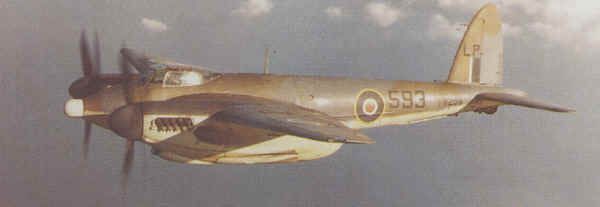
The Mosquito was one of the most remarkable planes of World War Two. The Mosquito – in full the De Havilland DH-98 Mosquito – was a twin-engine, two-seat bomber that was modified to serve as a fighter which could operate during the day or at night or as a photoreconnaissance plane. In whatever capacity, the Mosquito proved to be immensely successful – for a ‘wooden’ plane.
The idea for the Mosquito was forwarded to the government as early as 1938. The De Havilland design team based the Mosquito on their plane, the DH-88 Comet, which had won the 1934 London to Melbourne air race. De Havilland’s idea was simple – to power the plane with two Rolls Royce Merlin engines so that its sole defence, other than the skill of the pilot, was sheer speed to keep it out of harms way. The structure of the Mosquito was to be entirely made out of wood with a stressed skin of thin laminated plywood over a balsa core. The first Mosquito flew in November 1940, and it went into production soon after.
The first Mosquitoes were powered by two 1,250 horsepower Merlin engines. To enhance its aerodynamics, all tail surfaces were elliptical and the wings were sharply tapered. The original Mosquitoes were designed to internally carry four 500 lb bombs. The first flights of the Mosquito confirmed what the design team had hoped for – the fastest operational plane of its day. The Mks II, III ands IV could fly at 380 mph – 19 mph faster than the Battle of Britain Spitfire and 50 mph faster than the Hawker Hurricane.
To go with its speed, the Mosquito also had an excellent operational range (1,800 miles) and ceiling (the Mk XV had a ceiling of 44,000 feet). With such qualities, the Mosquito was an excellent plane for photo reconnaissance and it started this task in September 1941. With its greater range, the Mosquito outperformed Spitfires converted for the same task.
In May 1942, bomber versions were introduced. The increased power of the Merlin engines allowed the Mosquito to carry heavier and heavier bombs. Later versions of the Mosquito could fly at 415 mph with a 4000 lb bomb load. Such a speed made it very difficult for the Luftwaffe’s fighters to attack it successfully. The only plane that would have had a chance against the Mosquito was the Me 262.
The Mosquito was used for a variety of tasks. It was used as a pathfinder plane during bombing raids on Germany. Flying with Bomber Command at night, it would attack a specific target ahead of the main bombing force, guiding them to that target. The Mosquito suffered fewer losses than any other plane attached to Bomber Command. The Mosquito was also used for the bombing of specific targets as it had the speed for low level accurate bombing. Some Mosquitoes were equipped with heavy cannon and were used to attack German armour on battlefields in western Europe. Some were equipped with night-fighting radar and as a result, the Mosquito became the most successful British night-fighter. Some Mosquitoes were fitted out with rockets and attacked Nazi shipping.
With its multiple role capacity, the Mosquito proved a very valuable plane for the RAF. Production of the plane continued until 1947 and in all 7,781 of them were made. The Mosquito continued serving the RAF as a reconnaissance plane until 1955.